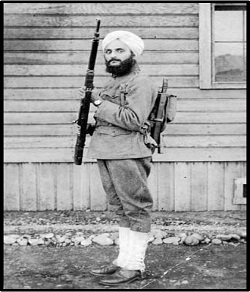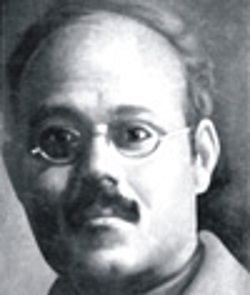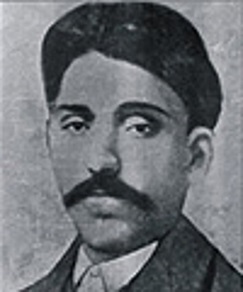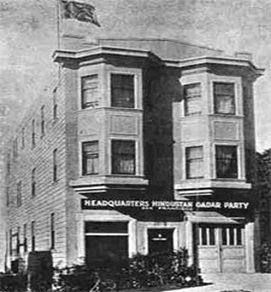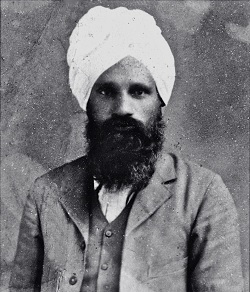The Ghadar Party was an organisation founded by Punjabis, principally Sikhs, but also Hindus and Muslims, in the United States and Canada with the aim of securing India's independence from British rule. It was an revolutionary association of Indians with headquarters at San Francisco. Key members included,Bhai Parmanand, Sohan Singh Bhakna, Har Dayal, Kartar Singh Sarabha, Abdul Hafiz Mohamed Barakatullah, Rashbehari Bose and Gulab Kaur, Harnam Singh.
In the early twentieth century, five to six hundred men and one family of East Indians lived along the Columbia River, from The Dalles to the coast, with the largest numbers settling in St. Johns and Astoria. A small group also worked for the railroads in southern Oregon. The men were often called “Hindus” by the newspapers and others—a derogatory term, a misunderstanding of their faith, and a reference to Hindustan (roughly present-day India and Pakistan). East Indians, mainly Sikh men from Punjab and Hindus and Muslims from other regions of India, migrated to the United States because of the harsh conditions—plagues, famines, and political conflict—in Hindustan under British colonial rule. Part of an international diaspora, the East Indian community in North America worked primarily in lumber mills in the Pacific NW and British Columbia, and in agriculture in California.
In the spring of 1913, East Indians formed the radical nationalist Ghadar Party in Astoria. The meeting was held in the Finnish Socialist Hall, reflecting the important ties and comradery East Indian activists had, in Astoria and elsewhere, with socialists, radical labor organizers, and Irish, Finnish, Mexican, and Chinese nationalists. East Indians were sometimes called “coolie slaves” and targeted by white violence. With time and experience, many East Indians came to believe that the lack of self-rule in their country was the cause of their suffering and disrespect the world over, and they vowed to make change. After years of work and discussion, East Indian laborers, activists, students, and intellectuals organized and attended Ghadar’s founding meeting in Astoria, arriving by rail, boat, and car and on foot from British Columbia, San Francisco, and communities along the Columbia River.
The word ghadar translates as mutiny or revolution, and it indicates its adherents’ strategy. With the outbreak of World War I, four to five thousand men left the West Coast for India. Joined by men from the Philippines, Singapore, and beyond, they aimed to persuade the long-serving Sikhs of the British military to mutiny and thereby spark an armed general insurrection to end British rule. Their immediate plan was unsuccessful, and in India most were hung or jailed for life. In San Francisco, the home of Ghadar’s headquarters and newspaper, leading Ghadarites were tried and convicted in the then-largest federal trial ever mounted. Yet despite these significant setbacks, many today in India and in the larger diasporic community consider the Ghadar Party the opening salvo—imaginatively and practically—of the fight for Indian independence, which formally occurred in 1947.
Activists organized Ghadar in Oregon for several reasons. First, Oregon leaders like newspaperman Harvey Scott and Judge Matthew Deady developed a specific racial strategy for Oregon. By providing a safe environment, Oregon attracted and prospered from Chinese laborers and, later, “Hindus,” driven out by racial violence elsewhere in the West. Oregon leaders like Deady, Scott, and others took hard stands in the press and in the courts against race riots. Consequently, especially in western Oregon, there was much less anti-Asian violence than in the rest of the West. Many of these same Oregon leaders, however, also drafted constitutional measures in 1857 to ensure that Negroes, Mulattos, women, and Chinese—and later Japanese, East Indian, and Filipino—could never become citizens or vote. Oregon’s message to Asian laborers seemed to welcome them to work but not to stay.
East Indians did not have an idyllic life in Oregon. One man was killed in a hate crime in Boring in 1907. The community of East Indians in St. Johns was the target of widespread violence in 1910. In the wake of that riot, almost two hundred residents and the town’s mayor and police chief were charged with rioting by the Portland district attorney. Only one man was convicted. East Indians experienced less violence in Oregon than elsewhere in the West; and, unlike anywhere else in the West, perpetrators of violence against East Indians were prosecuted by governmental authorities in Oregon, if with mixed results. In addition to this relative, if uneasy, racial peace, Oregon was not a focus of the political police unit formed by British Columbian authorities and British colonial officials to target so-called Hindu nationalist organizers. That police unit was simply too small and too occupied in the East Indian radical centers of British Columbia and San Francisco to include activists in Oregon. Consequently, East Indian activists had a safer political environment in which to organize in Oregon given the lack of political police arrayed against them, the comparative racial peace in the state, and the significant community of radicals, especially in Astoria, offering them friendship and assistance in their efforts to change their country.

